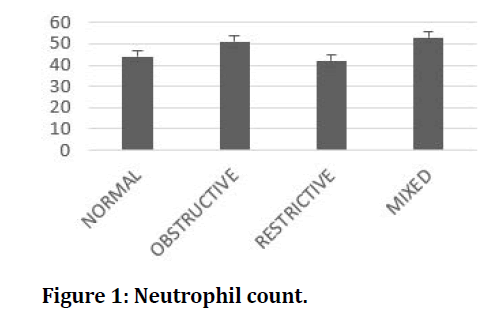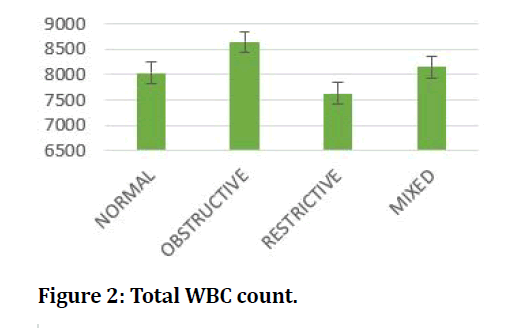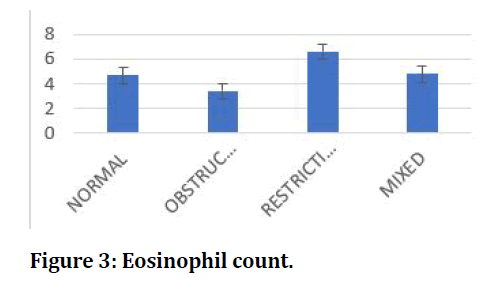Research - (2021) Volume 9, Issue 7
To Study the Relation Between PFT Abnormalities and Nasal Smear in General Population Residing in and Around Quarry in Zamin Pallavaram, Chennai
*Correspondence: Ilham Jaleel, Department of Physiology, Sree Balaji Medical College & Hospital Affiliated to Bharath Institute of Higher Education and Research, India, Email:
Abstract
The percentage predicted value of FVC (74.58 ± 20.59) was lesser than the percentage predicted value of FEV1 (77.41 ± 21.17) indicating that the vital capacity f the lung was more affected. it is evident that all the spirometric variables except FEVl % (FEVl/FVC ratio) are decreased, i.e., they are less than 80%. Hence it can be seen that both FEV1 which indicates the large airways, and FEF 25-75% that indicates smaller airways are both affected in our study population. The fibroblast stimulation factors that are released, cause collagen deposition and hyalinization. Hence the final lesion is a hyaline nodule, which contains a central zone with free silica that is surrounded by fibroblasts and collagen. Hence, the silica particles, which are deposited cause irritation of the respiratory mucosa, hypertrophy of the sub mucosal glands and hyper secretion of mucus. The hyper secretion especially in the large airways 1s stimulated by the proteases released from the neutrophils. we can see that there is slight increase in the hemoglobin level in the people having obstructive lung disease though it may not be significant. it is evident that the total WBC count is not much altered in the affected groups when compared to people with normal pulmonary function, there is significant change in the lymphocyte % in the people with restriction.
Keywords
Spirometric variables, Collagen, Hyaline
Introduction
It is known that au Pollution is associated with increased cardiopulmonary morbidity and mortality. Air Pollution can be broadly classified into two categories namely (a) reducing type pollution from combustion and photochemical pollution - from reactions involving UV radiation. Though several studies have been done to find out the lung function in stone quarry workers, or miners, 01:1-Iy a very few studies have been done to know the effect of industries such as mining industries, stone crushing industries, cement industries on the general population living around the industries which are a potential source of air pollution. Some of the studies show that even low dust level exposure for longer duration can affect the lung functions in the workers because of their exposure to silica dust [1-5]. On the other hand, risk of developing respiratory diseases is more in children and females due to emissions of industries for those who are living near them. Lung function is assessed with the help of spirometry. Restriction or obstruction of the lung can be measured with the help of several spirometric measures. Spirometry gives three important measures:
- FEVl (Forced Expiratory Volume in first second) - it is the volume of air that the patient can exhale in the first second of forced expiration. It is used as a measure of airway obstruction.
- FVC (Forced Vital Capacity) IS the total volume of air that can be expired after a maximum inspiration.
- FEVl/FVC: It is the ratio of FEVl to FVC. It Is expressed as a percentage.
- The extent of FEVl reduction indicates the severity of airflow obstruction.
Pulmonary function tests are a significant key factor to assess the respiratory health. Plenty of studies are being done so far to find out the impact of pollution on lungs. From the findings it said that elevated particulate matter exposures influence the impairment of lung functioning [1,2]. Some of the studies show that even low dust level exposure for longer duration can affect the lung functions in the workers because of their exposure to silica dusts. So, keeping these issues in mind, we aimed to test the pulmonary function of the general population who live around the Quarry or stone crushing unit in Zamin Pallavaram, Chennai, Tamil Nadu.
Methodology
Study design
This study was carried out m the Department of Physiology, Sree Balaji Medical College and Hospital. We recruited 60 subjects who were residents of Zamin Pallavaram, Chennai. Study was conducted after obtaining approval from the Institutional Ethical Committee. Questionnaire was given to all subjects to obtain information regarding family history, history of allergic rhinitis, duration of stay in that, rea. A wellinformed consent was obtained from all those who participated in the study. Pulmonary function tests, blood investigations and nasal smear was all done on the same day.
The subjects were included in the study based on the following inclusion and exclusion criteria.
Inclusion criteria
- They must be residents of Zamin Pallavaram.
- Age group: 20-60 years of age.
Exclusion criteria
- Smokers.
- h/o of tuberculosis.
- any acute respiratory illness.
- H/o recent surgeries.
- Pregnant women.
- h/o hypertension.
- h/o hernia.
- h/o cardiovascular diseases.
- h/o COPD.
- h/o Interstitial Lung diseases.
A study population of age group 20-60 years were included. The blood samples collected were analysed for the biochemical (RBC, TC, DC) and pathological (Hb¾, MCV, MCH, MCHC, PCV) blood parameters then pulmonary function test was performed by measuring FEVI (Forced Expiratory Volume in first second). Nasal smear was also collected and stained to observe neutrophils and eosinophils.
Statistics
All the values were expressed and Mean ± SD. The various spirometry variables namely FEY1, FYC, FY1/FYC ratio (FEY 1%), PEFR, FEF 25-75 were compared between the predicted value and measured value using the two-tailed unpaired t test. One-way ANOYA was done to find the significant difference between the various parameters of haematological indices with the pulmonary function abnormalities. Post Hoc analysis was also done.
Results
All the values were expressed and Mean ± SD. The various spirometry variables namely FEY1, FYC, FY1/FYC ratio (FEY 1%), PEFR, FEF 25-75 were compared between the predicted value and measured value using the two-tailed unpaired t test. One-way ANOYA was done to find the significant difference between the various parameters of haematological indices with the pulmonary function abnormalities. Post Hoc analysis was also done.
Table 1: Comparison of pulmonary abnormalities with haematological indices.
| PFT changes | RBC COUNT (4.5-5.5 millions/cu.mm.) | Hb¾ (12-16) gm/dl | MCV fl (78-96 fl) | MCH pg (27-33 pg) | MCH C gm/di (30-37 gm/di) | PCV % (40-47%) |
|---|---|---|---|---|---|---|
| Normal | 4.6 ± 0.42 | 12 ± 1.8 | 80 ± 11 | 26 ± 3.1 | 34 ± 4 | 45 ± 5.6 |
| Obstructive | 4.9 ± 1.00 | 14 ± 3- ! | 82 ± 4.2 | 28 ± 2.1 | 34 ± 2 | 40 ± 1.0 |
| Restrictive | 4.9 ± 0.45 | 12 ± 1.3 | 90 ± 13** | 26 ± 2.5 | 30 ± 3.9 ** | 42 ± 4.9* |
| Mixed | 4.5 ± 0.46 | 13 ± 2.2 | 81 ± 10 | 28 ± 3.4 | 34 ± 2 | 38 ± 3.8 |
Table 2: Spirometry variables and flow rates of study population.
| Parameters | Predicted value | Measured value | Percentage predicted |
|---|---|---|---|
| FEVl (L) | 2.18 ± 0.52 | 1.66 ± 0.64 | 77.41 ± 21.17* |
| FVC (L) | 2.61 ± 0.59 | 96 ± 0.76 | 74.58 ± 20.59* |
| FEVl/FVC ratio (FEVl %) | 90.87 ± 22.99 | 85.85 ± 141 | 102.55 ± 37.99 |
| PEFR (L/S) | 6.73 ± 1.17 | 4.77 ± 1.53 | 75.62 ± 22.88* |
| FEF2s-1s | 3.07 ± 0.65 | 2.21 ± 1.08 | 71.87 ± 34.20* |
*-Significant (p<0.05)
No significant change in the total WBC count is seen between those having normal pulmonary function and those having abnormal pulmonary function. However, there is significant change in the Lymphocyte % between the restrictive group and others. Other parameters like neutrophil, eosinophil, basophil, and monocytes showed no significant changes (Figures 1-3).

Figure 1: Neutrophil count.

Figure 2: Total WBC count.

Figure 3: Eosinophil count.
Discussion
Percentage predicted value of various spirometry valuables were found to be less than 80% except FEVl%. The percentage predicted value of FVC (74.58 ± 20.59) was lesser than the percentage predicted value of FEV1 (77.41 ± 21.17) indicating that the vital capacity f the lung was more affected, which is s like previous studies done [3,4]. This shows that restrictive lung disease was more prevalent in our study population these results are in concurrent with previous studies which stated that nasal cytogram for eosinophilia is equally efficient in diagnosing allergic respiratory diseases and that it can be used as an alternative to periphesmear for eosinophilia which in invasive.
An-Soo Jang demonstrated that the bronchial hyperresponsiveness may be due to nasal eosinophilic inflammation. In our study, Nasal smear was positive for two out of three subjects who had obstructive lung disease. Those who had restrictive lung disease were negative for nasal smear for eosinophils and the cytology had predominantly neutrophils.
There was significant difference in the lymphocyte % the restrictive group indicating the role of chronic inflammation in the pathogenesis of restriction. However, the difference in eosinophil % was non-significant. The allergic response in obstructive lung disease was evident by the presence of eosinophils in nasal smears [6-10].
Hence it can be concluded that residing near quarry or stone crushing unit may affect the pulmonary function while the pulmonary function abnormalities may be reflected by changes in the blood parameters and that the type of abnormality may be linked to the duration of exposure to the quarry dust.
Funding
No funding sources.
Ethical Approval
The study was approved by the Institutional Ethics Committee.
Conflict of Interest
The authors declare no conflict of interest.
Acknowledgements
The encouragement and support from Bharath Institute of Higher Education and Research, Chennai, is gratefully acknowledged. For provided the laboratory facilities to carry out the research work.
References
- Committee of the Environmental and Occupational Health Assembly of the American Thoracic Society: Health effects of outdoor air pollution. Am J Respir Crit Care Med 1996; 153:3-50.
- Hoek G, Dockery DW, Pope A, et al. Association between PM 10 and decrements in peak expirtory flow rates in children: Reanalysis of data from 5 panel studies. Eur Respir J 1998; 11:1307-1311.
- Lioy PJ, Zhang J, Swift DL, et al. Air pollutants and the respiratory tract. New York, NY: Marcel Dekker, Inc. 1999; 1-38.
- Suresh KS, Chowdhary GR, Gopal P. Assessment of impact of high particulate concentration on peak Expiratory flow rate of lungs of sand stone quarry workers. Int J Environ Res 2006; 3:355-359.
- Bertoldi M, Borgini A, Tittarelli A, et al. Health effects for the population living near a cement plant: An epidemiological assessment. Environment Int 2012; 41:1-7.
- Souza MB, Saldiva PH, Pope III CA, et al. Respiratory changes due to long-term exposure to urban levels of air pollution: A histopathologic study in humans. Chest 1998; 113:1312-8.
- Sivacoumar R, Jayabalou R, Swarnalatha S, et al. Particulate matter from stone crushing industry: Size distribution and health effects. J Environ Eng. 2006; 132:404-414.
- Mom oh A, Mhlongo SE, Abiodun 0, et al. Potential implications of mine dusts on human health: A case study of Mukula Mine, Limpopo Province, South Africa. Pak J Med Sci 2013; 29:14 44-1446.
- Gotschi T, Sunyer J, Chinn S, et al. Air pollution and lung function the European community respiratory health survey. Int J Epidemiol 2008; 37:1349-1358 .
- Ghio AJ, Kim C, Devlin RB. Concentrated ambient air particles induce mild pulmonary inflammation in healthy human volunteers. Am J Respiratory Critical Care Med 2000; 162:981-8.
